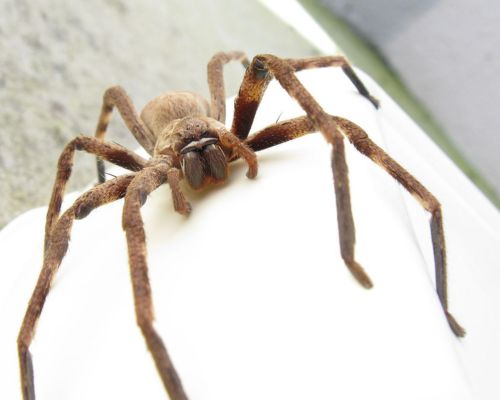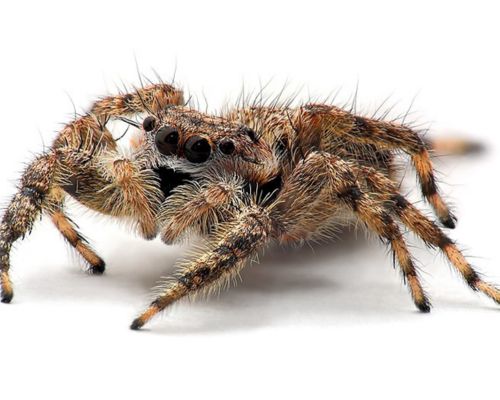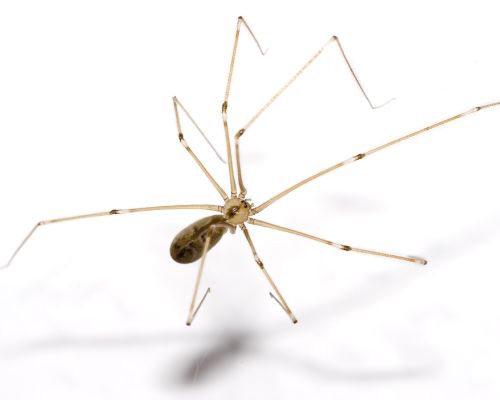Australia, the land Down Under, is home to some remarkable creatures, including spiders. These eight-legged wonders play a crucial role in the Aussie ecosystem. Let’s take a friendly stroll through the top 10 types of spiders in Australia, learning a bit about each of these interesting arachnids.
Australia’s spiders vary widely, from the large and camouflaged Huntsman spiders to the notorious Redback spiders with their red stripes. In this exploration, we’ll uncover the unique traits that make these spiders fascinating.
Top 10 Types of Spiders in Australia
Huntsman Spiders

The Huntsman spiders are number one on our list of the top 10 types of spiders in Australia. Huntsman spiders, big and flat, aren’t as scary as they seem. With long legs and a brownish hue, they’re masters of hiding. These sizable arachnids can reach an impressive leg span of up to 1 foot. These spiders prefer cozy spots in your home, like behind curtains or under furniture.
In their lifecycle, tiny Huntsman spider babies hatch from eggs and grow into adults. They molt, shedding their old skin to make room for a bigger one.
Huntsman spiders aren’t web-makers; they’re hunters. When night falls, they emerge, looking for insects to munch on. Fear not, though – they’re harmless to humans. So, if you spot one, let it be your silent insect warrior, keeping your space bug-free.
Redback Spiders

The Redback spiders are next on our list of the top 10 types of spiders in Australia. Redback spiders, with their telltale red stripe, are small yet pack a punch. These spiders measure around half an inch, but their venom is noteworthy. The spider’s life cycle starts with tiny eggs, hatching into spiderlings that grow through molting stages.
These spiders are skilled web weavers, constructing messy, tangled webs where they patiently await unsuspecting prey. Despite their small size, the red stripe warns of potential danger. Thus we recommend getting the best spider control service in Perth for your protection.
During mating, the female Redback often consumes the smaller male afterward, a behavior unique to these spiders. While their venom is potent, causing discomfort, it rarely poses a severe threat to humans.
Funnel Web Spiders

Funnel Web spiders are not your average arachnid. They boast a robust appearance and measure around 2 inches in size. During their lifecycle, eggs transform into spiderlings, which grow into formidable adults through molting stages.
These spiders are notorious for their aggressive nature and are often found in cool, damp areas. Their impressive silk-lined burrows serve as both homes and traps for unsuspecting prey.
Encountering a Funnel Web spider can be intimidating due to their venomous bite. Still, the good news is that prompt medical attention can effectively treat it. Despite their fearsome reputation, these spiders play a part in keeping the balance of their ecosystem.
Wolf Spiders

Wolf spiders, agile hunters of the night, bring a unique charm to Australia’s spider community. These spiders are recognized by their distinctive appearance and can grow as large as 2 inches. Contrary to their name, they don’t spin webs but instead rely on their sharp eyesight and quick legs for hunting.
In the lifecycle of a Wolf spider, tiny spiderlings emerge from eggs and undergo several molting stages to reach adulthood. These arachnids are nocturnal, prowling at night to locate their prey.
Known for their beneficial role in controlling insect populations, Wolf spiders are generally harmless to humans. Despite their formidable appearance, these spiders prefer to avoid confrontation and are more interested in contributing to the natural balance of their habitat.
Jumping Spiders

Jumping spiders, the acrobats of the arachnid world, bring a touch of agility and charm to Australia’s diverse spider population. These petite spiders, measuring just a few millimeters, captivate with their keen eyesight and remarkable jumping abilities.
In the lifecycle of a Jumping spider, tiny spiderlings hatch from eggs and undergo several molting stages to reach adulthood. Unlike their web-spinning counterparts, Jumping spiders rely on their incredible agility and excellent vision for hunting.
Found in various habitats, from gardens to homes, Jumping spiders play a crucial role in pest control. Their ability to leap from place to place allows them to ambush prey effectively. Despite their tiny size, these spiders contribute significantly to maintaining a balanced ecosystem.
So, if you spot a Jumping spider, marvel at its acrobatic feats and consider it a friendly neighborhood helper in keeping pesky insects at bay. These little performers are a testament to the fascinating diversity of Australia’s arachnid residents.
Orb-Weaving Spiders

Orb-weaving spiders, the silk architects, showcase nature’s intricate craftsmanship among Australia’s arachnid residents. Known for their captivating webs, these spiders vary in size, with some species boasting impressive spans.
In the lifecycle of an Orb-Weaving spider, tiny eggs hatch into spiderlings. Through molting stages, they grow into skilled web builders. The silk they spin is not just a trap for prey but also a work of art.
These spiders employ remarkable web-building techniques, creating intricate patterns that serve as a shelter and a means of capturing insects. The diversity of Orb-Weaving spiders adds a touch of elegance to the Australian spider community.
Trapdoor Spiders

Trapdoor spiders, masters of camouflage, introduce a fascinating aspect to Australia’s spider family. These spiders, known for their distinctive burrowing habits, showcase impressive adaptations for survival.
Measuring about an inch in size, Trapdoor spiders are experts in creating burrows with a camouflaged lid. In their lifecycle, tiny spiderlings emerge from eggs and gradually grow into adults through molting stages.
Camouflaging themselves with soil and vegetation, these spiders patiently wait for off-guard prey to pass by. Despite their intimidating appearance, Trapdoor spiders pose little to no risk to humans and are generally shy creatures.
White-Tailed Spiders

White-Tailed spiders, with their distinctive mark, add a touch of intrigue to Australia’s spider diversity. These spiders, measuring about half an inch, are recognized by the white tip at the end of their abdomen.
In the lifecycle of a White-Tailed spider, tiny spiderlings emerge from eggs, growing through molting stages into adults. Their preference for hiding in dark, sheltered places makes them occasional visitors to homes.
Identification of White-Tailed spiders is essential, as their bites can cause discomfort. While encounters are rare, understanding their appearance and habits helps residents take necessary precautions.
Despite their potential medical concerns, White-Tailed spiders contribute to the ecosystem by hunting other insects.
Daddy Longlegs

Last on our list of the top 10 types of spiders in Australia are the Daddy Longlegs. Daddy Longlegs, often misunderstood, are gentle arachnids with spindly legs and small bodies. Contrary to popular belief, they aren’t spiders but belong to a different group called harvestmen.
Measuring around 2 inches, Daddy Longlegs are harmless to humans. They don’t possess venom or silk glands and are more like wandering leaf litter cleaners.
In their lifecycle, Daddy Longlegs hatch from eggs into tiny versions of their adult selves. These creatures prefer damp areas like gardens, where they roam for small insects and debris.
Enamelled Spider

The Enamelled Spider is a lesser-known but captivating arachnid in Australia. It boasts a unique appearance and interesting habits. With a body length of about half an inch, these spiders are relatively small.
In the lifecycle of an Enamelled Spider, tiny eggs hatch into spiderlings, and through molting stages, they grow into adulthood. Their distinctive feature is the glossy, enameled-like appearance of their abdomen, making them stand out among other spiders.
Enamelled Spiders are skilled web weavers, creating delicate yet effective webs to capture prey. They prefer low vegetation and shrubs for their webs, strategically placed to intercept passing insects.
Conclusion
As we wrap up our journey through these types of spiders in Australia, it’s clear these creatures are more than just spooky critters. Each spider, from the acrobatic Jumping spiders to the silk-spinning Orb-Weaving spiders, contributes to the balance of nature.
Understanding spiders is like getting to know your neighbors – it helps us live together peacefully. So, next time you spot a spider, remember it’s just doing its part in the intricate dance of life.
In the end, Australia’s spiders may seem a bit different, but they’re an essential part of our unique ecosystem. Let’s appreciate these arachnids for what they are, marvel at their diversity, and continue coexisting harmoniously with the fascinating world of Australian spiders.
FAQ’s
Q. Are all spiders in Australia venomous?
While many spiders in Australia have venom, not all are dangerous to humans. Most spiders prefer to avoid human interaction.
Q. How can I identify a dangerous spider?
It’s essential to educate yourself on the distinctive features of venomous spiders. Seek professional advice if uncertain.
Q. Are huntsman spiders harmful?
Huntsman spiders are generally harmless to humans and are beneficial in controlling insect populations.
Q. What should I do if bitten by a redback spider?
Seek immediate medical attention if a redback spider bites, as their venom can be dangerous.
Q. Can trapdoor spiders be kept as pets?
While trapdoor spiders can be fascinating to observe, it’s crucial to consider their natural habitat. It is needed before attempting to keep them as pets.

